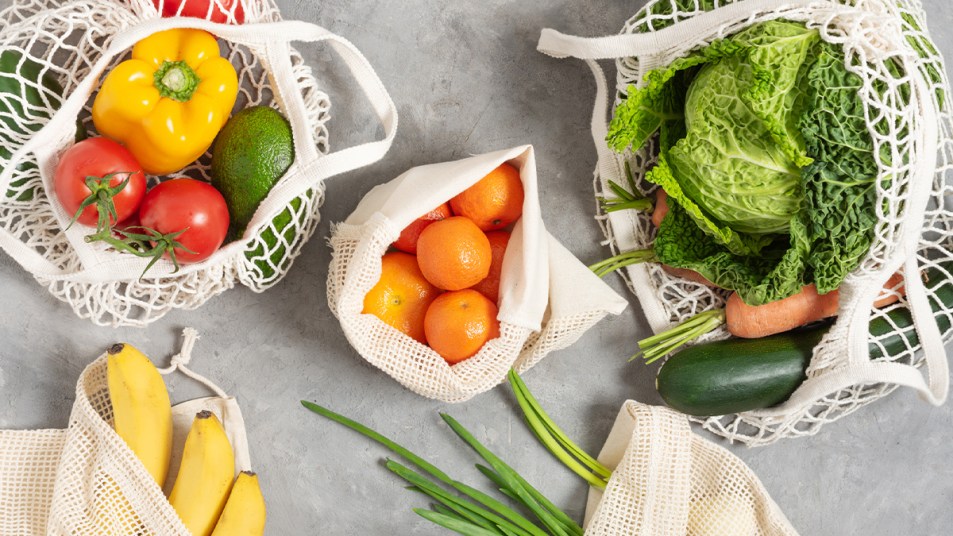10 Ways to Use Less Plastic at Home That are Easy and Eco-Friendly

Many of us are making moves towards greener living. Luckily, if you want to reduce the amount of single-use plastic you use at home, it’s easier than you might think. “It’s easy to feel overwhelmed when you begin looking at how you can reduce your plastic use,” says Niccii Kugler, founder of Nash + Banks, an ethical and eco-friendly online marketplace. “Start by focusing on one area at a time, for example your bathroom, and start by phasing eco-friendly options in next time you need to replace an item.”
“A good place to start is by replacing your everyday plastic items with those that can be thrown into your home compost after use. There are compostable alternatives for everything from toothbrush handles to iPhone cases,” she adds.
Ready to rid your home of plastic? Here are some simple ways to reduce your plastic footprint and make more sustainable choices.
Stop using plastic shopping bags.
“The kitchen, and specifically the pantry, accounts for a huge amount of single-use plastic. Keep a set of reusable shopping bags handy in your car for food shopping and grab your fruit and veggies “naked” to avoid using unnecessary plastic bags on fresh produce. You can go that step further by shopping with your own reusable containers for pantry staples like pasta, legumes and nuts at bulk food stores.” Kugler says.
Stop buying halves of fruit and vegetables.
“Buying half a melon, squash, cauliflower, cabbage, or papaya means having plastic wrap. Buy them whole and get a little recipe inspiration to ensure you use them all up over the week,” Alexx Stuart, author of Low Tox Life (Buy on Amazon, $14.37), says. “You could roast half your cauliflower with turmeric and olive oil then blitz the other half into a puree with coconut milk and sea salt. Different textures and flavors means not getting bored!”
Opt for glass or reusable plastics.
“Stop buying convenient ‘squeeze-tops’ for products like tomato sauce, honey, and mayo. Choose a glass jar or make your condiments yourself. You can grab a teaspoon and take out what you need. You can reuse the glass jars for pantry items, storing stock and so on,” Stuart adds.
Love the taste of bottled water? Another simple way to nix the single-use plastic is with a filtration jug which reduces chlorine, metals and pesticides from tap water resulting in pure tasting water minus the plastic. Not only will your tea, coffee, and drinking water taste better, you’ll be helping the environment and your pocket as, in the case of the Brita water filter jug (Buy on Amazon, $27.99), each recyclable cartridge can filter about 100 liters of tap water, which eliminates the need for up to 100 one-liter single-use plastic bottles!
Ditch the plastic wrap.
“You can get reusable bowl covers, beeswax wraps, silicone bowl covers, or just pop a plate over the bowl. It’s one of those things that you just don’t need to replace when you’re out next time. You’ll soon see you really didn’t need it. I have a few tiny glass containers or jars for little things like half a lemon, opened goat’s cheese and so on,” Stuart says.
Use bar soap.
“Choose packaging-free, solid beauty products wherever you can,” Kugler notes.
Switch to reusable razors.
“Billions of disposable plastic razors end up in landfill every year. A reusable safety razor is a one-off investment that will also save you money in the long run. The razor itself will last forever and the replacement blades are inexpensive and recyclable,” Kugler says. “Australian brand Kappi does a range of safety razors that look amazing in your bathroom in matte black, rose gold and gold.”
Sleep in natural fibers.
“Bedding is a great place to start in the bedroom. Consider the materials that you are choosing. Synthetic fibers shed microplastics into the water supply each time you wash them. Choose quality natural fabrics like certified organic cotton, linen, or bamboo for sheets and duvet covers and look at what pillows and cushions are filled with too,” Kugler adds. “Choosing to support brands that have made a commitment to plastic-free packaging, from swing tags to compostable mailers, is another step in the right direction.”
Watch what you wear.
Have you ever thought about how the clothes you wear impact the environment? From production to postage, plastic is used in the creation and distribution of clothing and textiles, with much of it ending up in landfill or in our oceans. Choosing to support and shop from clothing brands who are committed to minimizing their plastic footprint, is the first step towards a more sustainable wardrobe.
Buy in bulk.
“Your laundry detergent is another grocery item you can buy in bulk with your own container” Kugler says.
Make your own cleaning products.
Making your own natural cleaning products is another way to reduce plastic waste, along with nasty chemicals, in the home. If you’re unsure where to begin with natural cleaning, here are seven basic organic DIY cleaning solutions that you can mix up in reusable glass spray bottles.
Simple Ways to Say No to Plastic
- Say no to straws. If you like using a straw, you can buying reusable stainless steel straws to keep in your handbag and at home.
- Don’t buy plastic for parties or picnics. Buy biodegradable bamboo plates and utensils instead or, bring your own plates and utensils from home.
- Buy dried goods in bulk rather than from the supermarket.
- Have your coffee at the cafe or take a reusable cup.
This article originally appeared on our sister site, Homes to Love.












